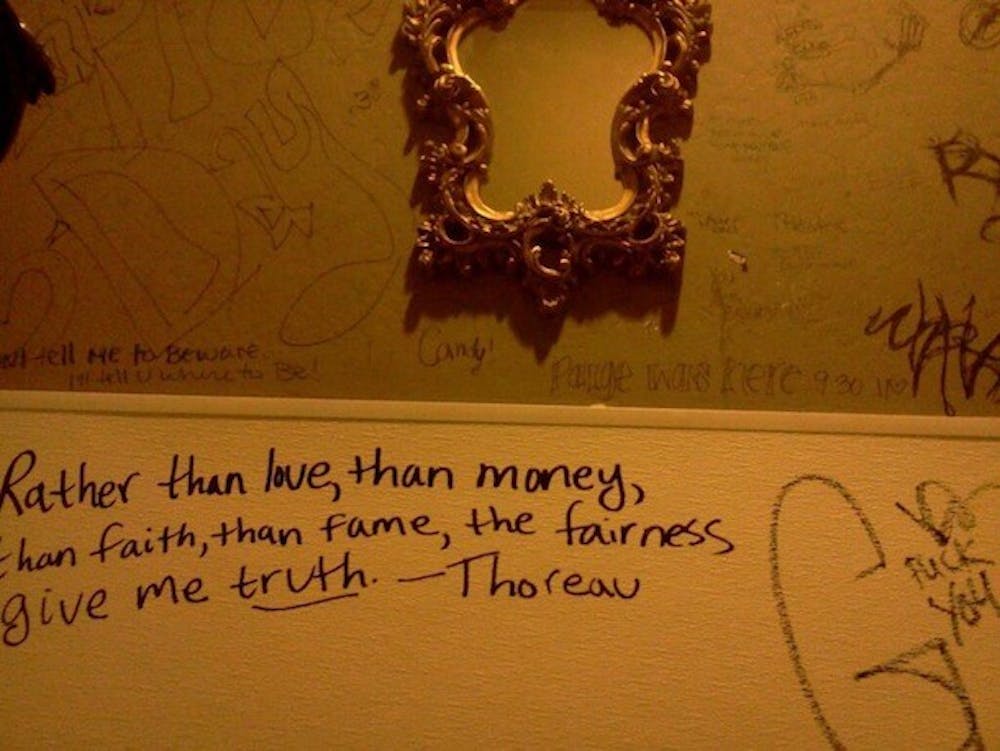 The throne's door at Cartel.
The throne's door at Cartel.Photo by Kharli Mandeville
 Existential in a revered room at Cartel.
Existential in a revered room at Cartel.Photo by Kharli Mandeville
Local bands, promoters, graffiti writers and various Tempe hipsters hyped on Americanos and armed with sharpies have all found themselves in this private quarter. I learned that nothing is quite as awkward as realizing how long you've suspiciously occupied a restroom.Small-bladdered people prancing around within earshot of the sound of a camera shutter really put a damper on one's graffiti admiration. I also learned that toilets are really high off the ground. My love affair with bathroom graffiti began in the women’s restroom at Long Wongs during a show last year. I have a photo from that night of the sweet graffiti they used to have before they recently began to repaint. (Actually, the photo is of a Thoreau quote I scribbled on the wall after the cute door guy gave me and my friend a paint marker and told us to use it.)We left my guy friend on purse duty out on the patio and headed together into the bathroom, promising the poor guy we’d be back straight away. What we didn’t anticipate is what the photo I have doesn’t show: a succession of very unfortunate events I like to think of as our version of a scene in a “Dumb and Dumber” movie.
Before disaster struck, I wrote what I had to say on the wall just fine. Well, not really. I mixed up “the” with “than,” and I have no excuse other than obviously I was buzzed and got it on the wall and me out of the restroom. Anyway, my also-buzzed friend went to pull the cap off of the marker, pulled a little too hard, and paint flew everywhere. Everywhere. Streaks and puddles of black paint covered the floor, the wall, and the sink.Our eyes widened in shock and our jaws dropped in horror as we each grabbed paper towels and tried to rub the paint off of the floor. No. The paint smeared ever further. Then we tried to clean the sink. No. In desperation, we continued to “clean” and smear as a line of very angry restroom occupants grew just outside the door. We gave up.We took simultaneous deep breaths and opened the door. We acknowledged the girls outside the door, as we looked behind ourselves in exasperation toward our wreckage. We advised the girl next in like to be careful in there, someone spilled paint all over the place. I’m not sure we realized just yet that we were each splattered head to toe in incriminating black smudges.
 The Fixx, once home to magic.
The Fixx, once home to magic.Photo by Kharli Mandeville
 Mirror, mirror on Long Wongs.
Mirror, mirror on Long Wongs.Photo by Kharli Mandeville
I loved those restrooms. As a political science major, most of my classes end up in Coor, so I’m familiar with those stalls more than any others on campus. The art in there was actually decent. A girl used wheat paste to glue her drawing onto one of those stalls, and I’m telling you, it was rad. I think I loved them most because of their implied creators: history, global studies, and political science majors like myself. To me, the story told in this building’s restrooms was one of the creative release (no pun intended here) of students with similar aspirations to my own, likely bogged down in homework and daily stresses, leaving their mark upon a stall they likely frequent regularly.
I use the past tense here, because after spring break and to my dismay, I came back to these stalls, fortresses of creative solitude away from the hustle and weight of academia that they are, and discovered they had been painted over.
I was a crazy person. Running and flipping open each stall in succession as I came to accept what I feared — the University had had enough of our silly bathroom shenanigans and had spring-cleaned away our outlet, our fortress.
I couldn’t understand why. For me, college was never all about growth within the stifling confines of academia. It is about growth in all areas of life. And art, even silly “My Little Pony” cartoon bathroom art, is just as essential to the exercise of the minds that are meant to form creative, progressive solutions to the world’s problems later in life.
I realize I’m being a little dramatic here, but I know I wasn’t the only person who knew that those restrooms showcased the best bathroom art on campus. No other stalls compared.
But all disappointment aside, herein lies the beauty in dark times such as these: The University handed us a clean canvas.
Rest in peace, Coor bathroom graffiti. You are forever in our hearts.
 You'll be missed, COOR art.
You'll be missed, COOR art.Photo by Kharli Mandeville
Reach the writer at kharli.mandeville@asu.edu or on Twitter at @kaharli




